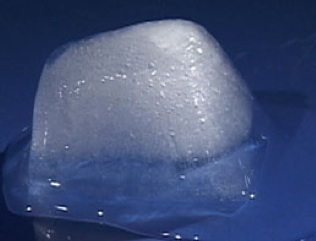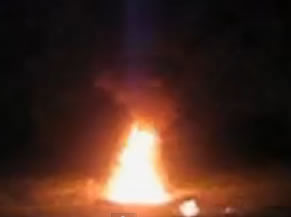|
|
|
All changes in state are physical changes. These processes are reversible. There is no change in the structure of the atoms or molecules involved. They can go back and forth between states with small inputs or withdrawals of heat. The mixture of ice cubes and liquid water can be 'pushed' to more ice if the mixture is cooled. Conversely the amount of ice can be decreased if a little more heat is added to te mixture. Some people are surprised to see that the ice and water mixture has a constant temperature until either all the ice melts or all the water freezes. Changes in state occur between a condensed form and an expanded or less condensed state. For example boiling a liquid converts a condensed state (the liquid) with particles close together to a dispersed state (the gas). The volume increase from liquid to gas is approximately a factor of 1000. The liquid is more condensed and has much less volume than the gas. This volume increase is one reason why aerosol cans have warnings saying they should not be incinerated. When the liquid in the aerosol can is vaporized the gas pressure will increase enough to explode the thin walled can. This rollover picture and the youtube video show what happens to an aersol can in a fire. |
|
The common phase or state changes are listed in this table. |
|
Compact state |
process |
Less compact state |
Heat effect type |
Name for heat effect |
|
Solid |
melting----> |
Liquid |
endothermic |
Heat of fusion |
|
Liquid |
boiling -----> |
Gas |
endothermic |
Heat of vaporization |
|
Solid |
sublimation---> |
Gas |
endothermic |
Heat of sublimation |
|
|
|
|
|
|
|
Gas |
condensation--> |
Liquid |
exothermic |
Heat of condensation |
|
Gas |
condensation--> |
Solid |
exothermic |
Heat of condensation |
|
|
|
|
|
|
|
Liquid |
freezing ------> |
Solid |
exothermic |
Heat of crystallization |
|
Note that endothermic changes occur when the system goes from a condensed state to an expanded state, the material is less compact. This results from the fact that energy is needed to "pry" apart a condensed state and there is a big entropy increase. The state with the bigger volume is more disordered and chaotic with greater entropy. Attractive forces are stronger in the condensed state of solids and liquids compared to gases. The stronger these forces the greater the energy needed to change the state to the expanded state. The reverse process of going from a chaotic state to a compact organized state has the opposite sign and is endothermic. |
|
|
|

